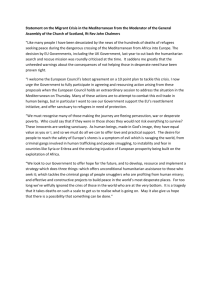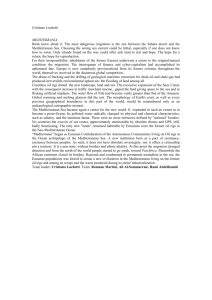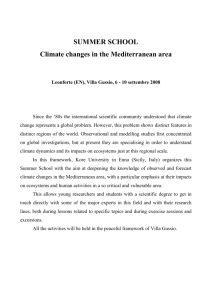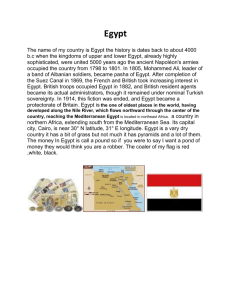Environmental data from coastal waters of the Mediterranean Sea in
advertisement
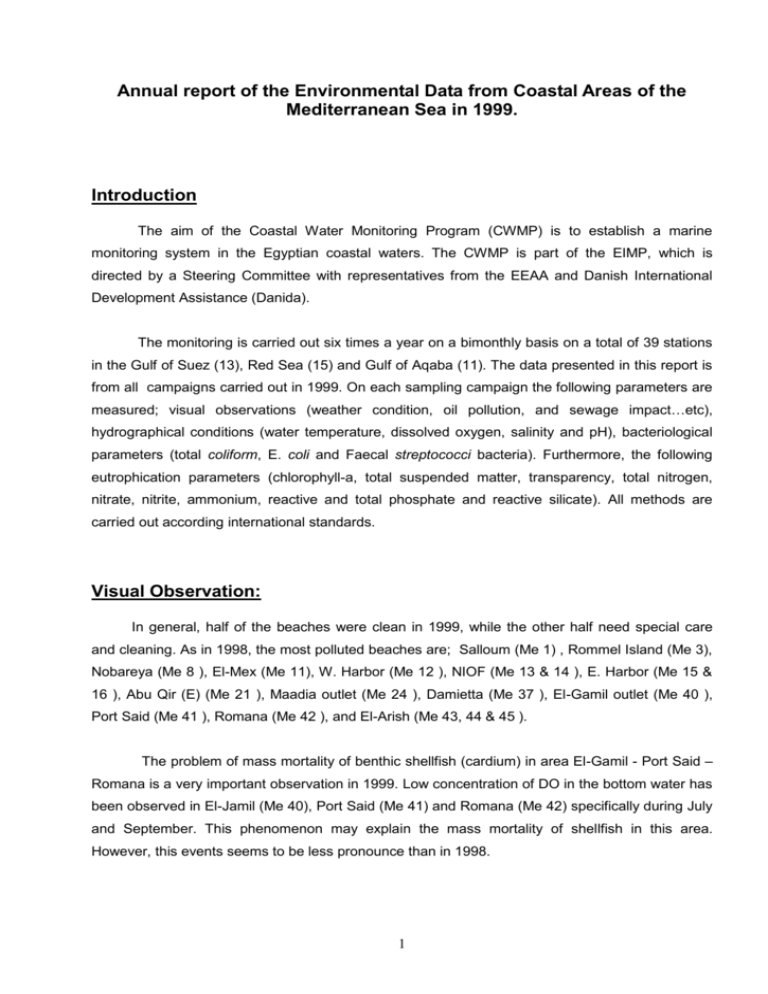
Annual report of the Environmental Data from Coastal Areas of the Mediterranean Sea in 1999. Introduction The aim of the Coastal Water Monitoring Program (CWMP) is to establish a marine monitoring system in the Egyptian coastal waters. The CWMP is part of the EIMP, which is directed by a Steering Committee with representatives from the EEAA and Danish International Development Assistance (Danida). The monitoring is carried out six times a year on a bimonthly basis on a total of 39 stations in the Gulf of Suez (13), Red Sea (15) and Gulf of Aqaba (11). The data presented in this report is from all campaigns carried out in 1999. On each sampling campaign the following parameters are measured; visual observations (weather condition, oil pollution, and sewage impact…etc), hydrographical conditions (water temperature, dissolved oxygen, salinity and pH), bacteriological parameters (total coliform, E. coli and Faecal streptococci bacteria). Furthermore, the following eutrophication parameters (chlorophyll-a, total suspended matter, transparency, total nitrogen, nitrate, nitrite, ammonium, reactive and total phosphate and reactive silicate). All methods are carried out according international standards. Visual Observation: In general, half of the beaches were clean in 1999, while the other half need special care and cleaning. As in 1998, the most polluted beaches are; Salloum (Me 1) , Rommel Island (Me 3), Nobareya (Me 8 ), El-Mex (Me 11), W. Harbor (Me 12 ), NIOF (Me 13 & 14 ), E. Harbor (Me 15 & 16 ), Abu Qir (E) (Me 21 ), Maadia outlet (Me 24 ), Damietta (Me 37 ), El-Gamil outlet (Me 40 ), Port Said (Me 41 ), Romana (Me 42 ), and El-Arish (Me 43, 44 & 45 ). The problem of mass mortality of benthic shellfish (cardium) in area El-Gamil - Port Said – Romana is a very important observation in 1999. Low concentration of DO in the bottom water has been observed in El-Jamil (Me 40), Port Said (Me 41) and Romana (Me 42) specifically during July and September. This phenomenon may explain the mass mortality of shellfish in this area. However, this events seems to be less pronounce than in 1998. 1 Hydrographic conditions: Investigation of the basic parameters revealed the levels of pH, temperature and salinity of the Egyptian Mediterranean Coast at the same levels as in 1998. pH Few locations have slightly acidic water. These stations were Western Harbor (Me 12) detected at Sept., Port Said (Me 41) detected at Sept. and Salloum (Me 1) detected at Nov. 99.All the other observation during 1999 were slightly alkaline. salinity In general the level of salinity was in the same range as for 1998. The annual maximum salinity value during 1999 was recorded at Romel ( Me 3 ) in July, this could be attributed to high rate of evaporation and the isolated character of this basin. The lowest salinity values during 1999 were detected in front of water discharge locations from inland to the Mediterranean Sea such as outfalls, outlets and Nile branches i.e. (Nobareya (Me 8), Mex (Me 11), NIOF (Me 13 & 14), Electrical Power Station (Me 22 & 23), El-Maadia (Me 24 & 25), Rashid (Me 29 & 30), Damietta (Me 38) and El-Gamil (Me 39 & 40). Dissolved Oxygen (DO) Low Oxygen concentration were recorded in the bottom water on some locations during May, July, Sept. and Nov. The higher DO values during May were detected in surface water of ElMaadia (Me 24) during May 1999. This is due to the high rate of mixing and presence of strong surface current. The lowest DO values were recorded during 1999 in the deep water of Abu Qir Bay at stations (Me 21, Me 22, Me 23, Me 24 & Me 25). This may be explained by the discharge of untreated wastes in the bay through Maadia outlet providing high levels of Organic and chemical materials. Also, low levels of DO were detected in the Eastern Harbor (Me 16) which is highly affected by organic material. These observations were found in March, May, July and September. Furthermore El-Mex (Me11) in November, which was affected by the discharged water from Umum Darin to El-Mex Bay. Figure 1 presents Oxygen concentration of the Mediterranean coast in 1999. 2 The annual mean of DO for 1999 (7.5 mg/l), was less than that recorded for 1998 (8.9 mg/l). Stations from Me 15 to Me 19 showed a wide variation of DO especially in July. 20. Max Mean Min 15. 10. Me 41 Me 38 Me 33 Me 30 Me 27 Me 23 Me 20 Me 17c Me 16 Me 13 Me 10 Me 7 0. Me 4 5. Me1 Dissolved Oxygen, mg/l Dissolved Oxygen concentrations in the Meditteranean coast of Egypt in 1999 Figure 1 presents Oxygen concentration (mg/l) of the Mediterranean coast in Egypt in 1999. Transparency With respect to transparency, the cleanest areas were recorded at many stations such as Matrouh (Me 2), Romil (Me 3) and Ras El-Kanayes (Me 4), while the most turbid stations were detected at El-Maadia (Me 24 & 25) and El-Gamil (Me 39 & 40). Bacteriological Parameters The occurrence of pollution indicator bacteria is used as sanitary parameters for evaluation of water quality. The interpretation of the detected bacterial indicators during 1999 was made according to Egyptian Guidelines, which accept the guide values of investigated bacteria by 500 bacterial counts/100ml sea water for coliform bacteria and 100 bacterial count /100ml sea water for E. coli and Faecal streptococci. In general, most of the investigated areas have relative low levels of bacteria. However 19 stations show high counts of one or more indicating bacteria exceeding the acceptable levels during at least one or more of the sampling campaigns. These stations are: Romel Island (Me 3), El-Mex area (Me 11), Western Harbour (Me 12), east and west of NIOF (Me 13 & 14), east of the harbor and at the area of fishing boats (Me 15 & Me 16), Sidi Gaber (Me 17b), Abu-Qir (Me 20 & Me 21), In front of Edku Town (Me 26), Rashid city 3 (Me 29), El-Burg (Me 33), In front of Damietta City, (Me 35, 36, 37 & 38) and In Port Said El-Gamil (Me 40 & 41), The numbers of pollution indicator bacteria detected in the western part of the Mediterranean till El-Alamin (Me6) did not exceed the acceptable limits. However at Romel Island (Me 3) counts of E. coli and faecal streptococci were increased to slight above the acceptable levels during summer, possibly explained by the high number of seasonal visitor of this recreational area. In front of Alexandria city in the western part of the city at El-Agamy in Hannoville and ElBitach (Me 9 and 10), low levels of the investigated bacteria were detected throughout the year. These area is highly populations during summer. Thus, these areas are considered a very clean and safe area for recreation. The numbers of the pollution indicator bacteria dramatically increased in sites started from El-Mex area (Me 11) and around the inner part of the Western Harbor (Me 12), east NIOF (Me 13) and west NIOF station (Me 14). This high degree of contamination was detected during all the six campaigns. These dramatic high bacterial numbers clearly indicate a discharge of untreated or only partially treated domestic wastewater into the sea in these sites. Further east of the harbor and in the area of fishing boats (Me 15 and Me 16), the bacterial counts exceeded the acceptable levels for coliforms bacteria and E. coli, throughout most of the six campaigns. However, faecal streptococci counts did not exceed the acceptable level here. In general, no clear seasonal variation was observed, in this area, during 1999. In Alexandria beach-outfalls sites, include El-Shatby (Me 17a), Sidi Gaber (Me 17b), Gleem (Me 17c) and Sidi Bisher (Me 17d), counts of the detected bacteria in these popular beaches were under the accepted levels. However, in summer season the detected three types of bacteria were slightly above the standard values. The campaign of January’s and on Sidi Gaber (Me 17b), have a high numbers of the pollution indicator bacteria exceed the permissible limits were detected. This may explained by the sewage outfall in the area-discharged sewage in that period of time. In particular beaches (closed beaches), in east of Alexandria city, like El-Mamoura (Me 18) and El-Montazah (Me 19), the counts of the investigated bacteria did not exceed the permissible limits during the whole year. A clear seasonal variation could be observed here in these areas, of popular or particular beaches, with the highest levels of the investigated bacteria were detected in summer where intensive use of these beaches occur. East of Alexandria city, at Abu-Qir area, (Me 20 and Me 21) numbers of the indicator bacteria were higher than the acceptable levels in several times during this year. This may be due to domestic wastewater discharge into this area. Results of bacteriological analysis of the Nile delta, showed that; in front of Edku Town (Me 26), Rashid city (Me 29) and El-Burg (Me 33) the investigated bacterial counts, of the pollution indicator bacteria, exceeded the acceptable numbers in two to five campaigns. Interestingly, Gamasa (Me ) which is considered as one of the recreational area, harbored numbers of the 4 investigated bacteria, exceeding the permissible values. This may be due to high human activities found there throughout the year especially during the summer season. In front of Damietta City, (Me 35, 36, 37 and 38), counts of coliforms bacteria exceeded the permissible levels only in summer time. However, E. coli counts exceed the permissible limit while faecal streptococci were under the permissible limit. In Port Said El-Gamil (Me 40), counts of coliform and presumptive E. coli frequently exceeded the permissible limits, however faecal streptococci were under the permissible values throughout the year. In front of Port Said, counts of pollution indicator bacteria exceeded the permissible limits in most of campaigns. However in North Sinai at Romana or El-Arish, lower numbers of bacteria were detected throughout the year. Nevertheless, these numbers were more higher in summer season where this area is heavy visited for recreational purposes From the bacteriological investigation of coastal area of Egypt, the following can be summarized: 1. The obtained results revealed on variable picture of the Mediterranean coast ranged from uncontaminated areas such as Ras El-Kanayes (Me 4), Marina (Me 6), Al-Agamy (Me 9 and 10), El-Mamoura (Me 18), El-Montazah (Me 19) and El-Arish (Me 43, 44 and 45) up to very high degree of contamination such as El-Mex (Me 11) and the inner part of the harbor of Alexandria (Me 12) and NIOF outfalls (13 and 14). 2. The bacterial levels were, in general, lower than detected last year regardless if these were higher or lower than the permissible limits adopted by Egyptian values. 3. Furthermore the numbers of polluted sites in 1999 were less than those of 1998. 5 Total Coliform bacterial counts in the Meditteranean coast of Egypt in 1999 Bacterial counts /100 ml 10000000 January 1000000 March May July September November 100000 10000 1000 100 10 Me45 Me43 Me41 Me38 Me36 Me34 Me29 Me21 Me19 Me17d Me17b Me16 Me14 Me12 Me10 Me06 Me03 Me01 1 Figure 2 presents the values of Total coliform Bacterial count/100ml of sea water on the whole Mediterranean coastline in Egypt in 1999. E. Coli bacteria in the Meditteranean coast of Egypt in 1999 1000000 March May July September November 100000 10000 1000 100 10 Me45 Me43 Me41 Me38 Me36 Me34 Me29 Me21 Me19 Me17d Me17b Me16 Me14 Me12 Me10 Me06 Me03 1 Me01 E. coli counts/100 ml January Figure 3 presents the values of E. coli Bacterial count/100ml of seawater on the whole Mediterranean coastline in Egypt in 1999. 6 Me45 November Me43 Me41 September Me38 July Me36 May Me34 March Me29 Me19 Me17d Me17b Me16 Me14 Me12 Me10 Me06 Me03 January Me21 1000000 100000 10000 1000 100 10 1 Me01 Faecal Streptoccoci bacterial counts /100 ml Faecal Streptoccoci bacterial counts in the Meditteranean coast of Egypt in 1999 Figure 4 represents the values of Faecal Streptoccoci Bacterial count/100ml of sea water on the whole Mediterranean coastline in Egypt in 1999. Eutrophication Parameters Nitrate and Nitrite (NO2+NO3): Three areas in the Mediterranean Sea show higher values of nitrate + nitrite: The first area in the area around Alexandria between El-Mex (Me11) to Sidi Gaber (Me 16b), the second area between Abu Qir, east (Me21) to Maadia (Me25) and finally from El-Burg (M33) to Port Said (Me41). General for these three areas is the existence of discharge of sewage and agricultural runoff from the River Nile, the coastal lakes and it related drainage system. Figure 5 shows nitrate + nitrite concentrations on the Mediterranean coast in 1999, where the highest values were recorded in September in Western Harbor (Me12), Abu Qir (Me22), Damietta (Me38) and Port Said (Me41). During November the highest values were recorded in Abu Qir (Me22 & 23), Maadia (Me24 & 25) and Eastern Harbor (Me15). 7 Nitrate + Nitrite concentrations in the Meditteranean coast of Egypt in 1999 40 Max NO2 +NO3-N, umol/l 35 Mean 30 Min 25 20 15 10 5 15 M e 17 M a e 17 c M e 19 M e 21 M e 23 M e 25 M e 28 M e 30 M e 32 M e 35 M e 38 M e 40 M e 42 13 e M M e M e 11 9 7 e M 5 M e 3 e M e M M e1 0 Figure 5. Represents nitrate + nitrite concentration (µmol/l ) on the Mediterranean coast in Egypt in 1999 . Total Nitrogen (TN): The Total nitrogen follows the same pattern as was high during January in at Mex (Me11) in January and May, at NIOF outfall (Me 14) during January, March and May , east of Abu Qir Bay (Me21) during January, Tabia (Me 22 & 23) during January and July, at Maadia outlet(Me 24) during January, at Dameitta (Me 38) in January, El-Gamil (Me 39) during January and May, at Port Said (Me 41) during September. These may be exposed to wastewater discharged in the Eastern harbor and the effect of Electrical power station in Abu Qir region as well as the effect of wastewater discharged from Lake Idku. Annual average of Total Nitrogen concentration in 1999 Total Nitrogen 200 Max Mean Min 150 100 50 Figure 6 represents Total Nitrogen concentration (µM/l ) on the Mediterranean coast in Egypt in 1999 . 8 Me 41 Me 38 Me 33 Me 30 Me 27 Me 23 Me 20 Me 17c Me 16 Me 13 Me 10 Me 7 Me 4 Me1 0 Ammonia (NH4): As for nitrite + nitrate, three areas in the Mediterranean Sea show higher values of Ammonia: The area around Alexandria between El-Mex (Me11) to Sidi Gaber (Me 17b), the area between Abu Qir, east (Me21) to Maadia (Me25) and finally from El-Burg (M33) to Port Said (Me39). Here the highest levels were recorded in November in El-Mex (Me 11), NIOF (Me13 & 14), Eastern Harbor (Me 15), Abu Qir East (Me21) and Tabia (Me22). Also high levels were recorded in September in Western Harbor (Me12) and Eastern Harbor (Me15). Very high concentration was found at the Electrical Power Station (Me 22) in January, High levels was also recorded in front of the hot spots of the delta area, in Ras El-Bar (Me36 & 37) and Damietta (Me38) during July. Figure 6 shows ammonia concentrations on the Mediterranean coast in 1999. Ammonia concentrations in the Mediterrane an coast of Egypt in 1999 Ammonia, umol/l 60 50 Max Mean 40 Min 30 20 10 M e1 M e 3 M e 5 M e 7 M e M 9 e 1 M 1 e 1 M 3 e M 15 e 1 M 7a e 17 M c e 1 M 9 e 2 M 1 e 2 M 3 e 2 M 5 e 2 M 8 e 3 M 0 e 3 M 2 e 3 M 5 e 3 M 8 e 4 M 0 e 42 0 Figure 6. Ammonia concentration (µmol/l) on the Mediterranean coast in Egypt in 1999. Reactive Phosphate (PO4): The highest level of reactive phosphate was detected in front of the main sewage outfall of Alexandria during March at NIOF (Me13 & 14) and at Port Said (Me 41). Other high levels of PO4 were detected during January at El-Tabia Pump Station (Me 22, 23) and El-Gamil (Me 39) outlet. High levels during November was also recorded at Maadia-east (Me 25) and El-Tabia Pump 9 Station (Me 22, 23) presumable explained by the wastewater and drainage water discharge from lake Idku outlet and the El-Tabia outlet. The above observations reveal a geographic pattern consistent with the values previously described for nitrite + nitrate and ammonia. Figure7 shows reactive phosphate concentrations on the Mediterranean Coast in 1999. Reactive Phosphate concentrations in the Mediteranean coast of Egypt in 1999 3.0 PO4-P umol/l 2.5 2.0 Max Mean Min 1.5 1.0 0.5 M e1 M e 3 M e 5 M e 7 M e 9 M e 11 M e 13 M e 1 M 5 e 17 M a e 17 c M e 19 M e 21 M e 23 M e 25 M e 28 M e 30 M e 32 M e 35 M e 38 M e 40 M e 42 0.0 Figure 7 Reactive Phosphate concentrations (µmol/l ) on the Mediterranean coast in Egypt in 1999 . Silica (Si): High concentrations of Silicate were recorded at El-Mex (Me11) in January, May and September, at NIOF (Me13) in January and March, at El-Tabia Pump Station (Me22 & 23) in January, July and November, and at El-Maadia (Me24 & 25) during July and November. Generally, the high concentrations are associated with the urbaized sites, and outlets and outfalls (i.e. NIOF outfall, El-Mex outlet, El-Tabia outlet). Also, in the Delta regions high concentration are associated with the drainage outlets at Damietta and El-Gamil outlet. Very high level at El-Gamil outlet (Me 40) during July and September. Also very high concentrations were recorded at Port Said (Me 41), during July and during Sept. These high levels could be attributed to the impact of El-Gamil outlet (Me 39 and 40) on Port Said (Me 41) region. Comparing the levels of 1998 with that 1999, it is found that the levels during 1999 were less than those recorded during 1998 10 30 25 20 15 10 5 0 Max Mean Me 42 Me 40 Me 38 Me 35 Me 32 Me 30 Me 28 Me 25 Me 23 Me 21 Me 19 Me 17c Me 17a Me 15 Me 13 Me 11 Me 9 Me 7 Me 5 Me 3 Min Me1 SiO4-Si, uM/l Silicate concentrations in the Meditteranean coast of Egypt in 1999 Figure 9 represents Nitrate + Nitrite concentration (µM/l ) on the Mediterranean coast in Egypt in 1999 . Most of the station have low concentration of silicate with irregular distribution, the highest concentration found at El-Mex (Me11), El-Gamil-east (Me40) and in the area between Electrical power station (Me22) and El-Maadia (Me25), with the maximum concentration at Electrical power station (Me23). Chlorophyll-a: High levels of Chlorophyll-a were prevailed at El-Mex (Me 11) in May and September, at Eastern Harbor (Me15, 16) in January, March, May, July and September, at Abu Qir Bay (Me 22, 23) and at El-Maadia outlet (Me 24) in May, July, September and November, at Damietta (Me 35) during May, July and September, at El-Gamil (Me 40) in September and Novamber, at Port Said (Me 41) in May, July, November and September. These high levels are influenced by the discharge of drainage water from El-Gamil outlet. figure 3 represents average chlorophyll-a concentrations on the Mediterranean Coast in 1999. In general, the highest mean of chlorphyll-a in 1999 was recorded during July campaign . 11 35 30 Max Mean 25 20 15 10 Min Me 42 Me 40 Me 38 Me 35 Me 32 Me 30 Me 28 Me 25 Me 23 Me 21 Me 19 Me 17c Me 17a Me 15 Me 13 Me 11 Me 9 Me 7 Me 5 Me 3 5 0 Me1 Chlorophyll-a, ug/l Chlorophyll-a concentrations in the Mediterranean coast of Egypt in 1999 Figure 10 represents average chlorophyll-a concentrations (µg/l ) on the Mediterranean Coast in Egypt in 1999. Total Suspended Matter (SPM): Generally, the levels of SPM in seawater varied from traces to a few mg/l. The study of total suspended matter in the Mediterranean coast of Egypt showed generally low concentration except at delta sector is associated with freshwater outlets (i.e. River Nile, El-Gamil outlet of Lake Manzalla). The highest concentrations were recorded in El-Tabia Pump Station (Me 23) and in ElBurg (Me 32, 33) during January, May and November. The high levels in El-Tabia Pump Station (Me 23) may be due to the agricultural runoff through El-Tabia outfall, in Damietta (Me 38) and in El-Gamil outlet (Me 39) during May, and also in Port Said (Me 41) . High levels was also recorded in Romana (Me 42) during March and May. These high concentrations could be attributed to the eastward currents associated with freshwater discharges from the delta region. In general, the highest mean recorded in 1999 was found during May campaign Total Suspended matter concentrations in the Mediterranean coast of Egypt in 1999 120 Max 100 Mean Min 80 60 40 20 12 Me 41 Me 38 Me 33 Me 30 Me 27 Me 23 Me 20 Me 17c Me 16 Me 13 Me 10 Me 7 Me 4 0 Me1 SPM 140 Conclusion Most of the area of the Mediterranean Sea are highly populated and have especial position as it has several tourists, populated, agriculture and industrial areas. So we found completely difference from one area to another. From the above we can divided the Egyptian coastal water of the Mediterranean Sea into four different areas in November 1999. 1. The Western area which start from Sallum to West of Alexandria. This area have a lot of beaches and tourists village that visited seasonally (station from 1 to 8)>this area was clean and unpolluted in November, 1999, while some station was recorded numbers of bacteria but below the detectable limits. 2. Alexandria, which considered very important area as it have high population, industrial, agriculture and tourism areas (stations from 9 to 21 ). The western part of Alexandria was clean and unpolluted infront of El-Bitach and El Hannoville beach. While in El-Mex (Me 11) the highest bacterial count along the Mediterranean coast of Egypt were recorded, and so the high level of Ammonia and Silicate. This may be due to sewage and industrial pollution. In the Western Harbor, North of NIOF and Eastern Harbor numbers of bacteria above the acceptable limits were recorded, So high levels of Ammonia were recorded, while eastern harbor (Me 15) was the only one of them recorded high level of Total Nitrogen. The public beaches of Alexandria was clean and unpolluted in November, 1999 while the recorded number of bacteria was above the acceptable limits east of Abu Qir. 3. Nile Delta area which characterized by the exposure to fresh water outlet from River Nile and also the outlet from agriculture area (station from 22 to 42). Most of the station in this area were recorded bacterial count above the acceptable limits (Rashid, El Burulus, Domietta and Port Said), and so high level of Ammonia were recorded in most of this stations. The most polluted were recorded in the area of El-Tabia and El Maadia were high levels of Nitrate, Ammonia, Total Nitrogen, Total Phosphorous and Silicate were recorded. 4. El-Arish was clean and unpolluted in November 1999. (Table 1 summarized the most important points for Mediterranean Sea in Novamber,1999 ) 13 Table 1 summarized the most important points for Mediterranean Sea in 1999. Station numbers Name Remarks Me 1 Sallum Me 2 Marsa Matrouh Me 3 Romil Island Me 4 Ras El-Kanayes Me 5 Sidi Abdul Rahman Me 6 Marina Me 7 Nobaria Me 8 Nobaria Me 9 Hannoville Me 10 El-Bitach 11 Me 11 El-Max 1 , 5 , 10 Me 12 Western harbour 1 Me 13 NIOF(east) 1,5 Me 14 NIOF(west) 1,5 Me 15 Eastern Harbour 1,3,5,6 Me 16 Eastern Harbour 1,5 Me 17a Shatby Me 17b Sidi Gaber Me 17c Gleem Me 17d Sidi Bisher Me 18 El-Mamoura Me 19 Montaza Me 20 Abu Qir- Northwest Me 21 Abu Qir-East 1 , 11 Me 22 Tabia 2 , 3 , 5 , 6 , 8 , 9 , 10 , 11 Me 23 Tabia 2 , 3 , 5 , 6 , 8 , 9 , 11 Me 24 Maadia, Idku Lake 2 , 3 , 5 , 6 , 8 , 9 , 10 , 11 Me 25 Maadia, Idku Lake 2 , 3 , 4 , 5 , 6 , 7 , 8 , 10 , 11 Me26 Idku 1 Me 27 Rashid 1 Me 28 Rashid 1 Me 29 Rashid 1 11 14 Me 30 Rashid Me 31 Rashid Me 32 El-Burge 1,8,9 Me 33 El-Burge 1,5,8,9 Me 34 Gamasa Me 35 Damietta El-Gededa Me 36 Ras El-Bar-West Me 37 Ras El-Bar-East 11 Me 38 Damietta 1 Me 39 Port Said(west) Me 40 Port Said(east) 2 , 5 , 10 Me 41 Port Said 1,2 Me 42 Romana 11 Me 43 El-Arish(west) Me 44 El-Arish(center) Me 45 El-Arish(east) 11 Notes: 1. Bacteria above acceptable level. 2. High Levels of chlorophyll-a 3. High levels of nitrate 4. High Levels of phosphate 5. High levels of ammonia 6. High levels of total nitrogen 7. High levels of total phosphate 8. High levels of total suspended matter 9. Low levels of transparency 10. High levels of silicate 11. Low oxygen concentrations 15


